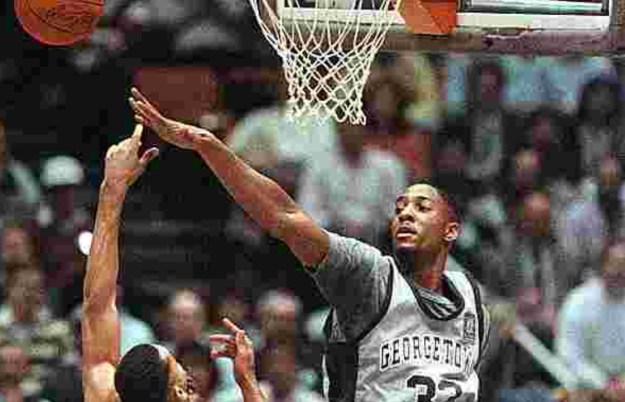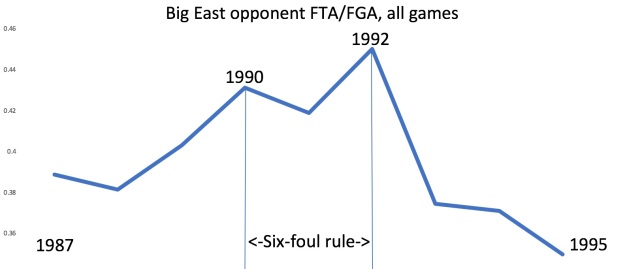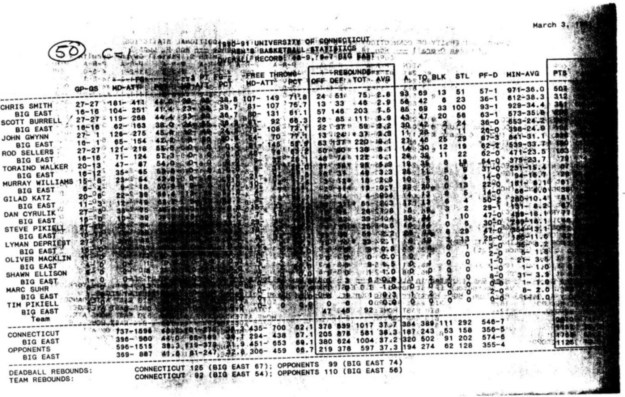
Those were the days. Sort of.
Every time my colleague Dick Vitale sees Zion Williamson take a seat on the bench after picking up two first-half fouls, he launches into an impassioned and loquacious plea (it’s true!) for increasing the number of personal fouls allowed per player to six.
And every time that happens, Twitter reacts to Dickie V with arch and snarky dismissiveness (it’s true!) and says it would never work.
Young turks on social media say, hey, great, just what we need, more fouls. Old geezers say, hey, I remember the old six-foul Big East from the 1990s, and it was awful.
Well, score one for the old geezers. Six fouls is not the answer, at least not now, and the Big East proved it between 1990 and 1992. (For the record, the Trans America Athletic Conference, the forerunner of today’s Atlantic Sun, joined the Big East in taking the six-foul rule out for a spin at that same time.)
On August 10, 1989, the news went out over the wires:
The Big East Conference will allow basketball players six fouls instead of five next season in an experiment that critics say will hurt underdogs by making it harder to get other teams’ star players out of games.
The six-foul rule and the proposed use of the 45-second clock rather than a hand count to measure 10-second violations were approved by a vote of the Big East coaches.
The coaches rejected a third experimental rule that would have given players three free throws instead of two if they were fouled while shooting three-pointers.
The Big East experiment from long ago merits a look today, for it suggests that visually pleasing basketball might indeed be the product of a delicate balance, just as traditionalists say it is. If you’re going to disqualify players after a certain number of fouls, there really does seem to be some kind of equipoise inherent to the one-foul-per-eight-minutes-of-game-clock ratio seen in both the college game and in the NBA.
To put it bluntly, the Big East experiment was something of a disaster, though not to Jim Boeheim and Jim Calhoun. “Our league was just as physical with five fouls,” Boeheim said with crusty and defiant truculence (it’s true!) in 1992 when the six-foul rule was ended.
In a manner of speaking, Boeheim was correct. Certainly no Big East team during the six-foul era fouled anywhere near as often as did Rick Pitino’s hacktastic pre-rule-change Providence team when it reached the 1987 Final Four with Billy Donovan.
The problem was that more or less the entire Big East started more closely resembling the Pitino-era Friars….

Not that there’s anything wrong with that, said Boeheim at the time:
The only thing you get [with six fouls] is better defense from your best players because they aren’t worried about it, and you get better basketball games because your best players are on the court.
Calhoun was also a fan of six fouls in 1992. “I don’t believe the Big East will be less physical,” he said when the rule was on its way out. “More guys are going to be in foul trouble. Now a guy gets two fouls and you’ve got to take him out of the game. I think six fouls should be used throughout college basketball.”
Boeheim and Calhoun had clout, but the final nail in the six-foul rule’s coffin was purely pragmatic. Other Big East coaches felt their teams were struggling to adjust to a five-foul game once the NCAA tournament began.
Nor did it help matters that a brash and youthful Washington Post columnist named Tony Kornheiser had labeled Big East basketball as unwatchable.
Let’s hear it for the genius who suggested that the Big East extend the personal foul limit from five to six in conference play. Not only does this put the teams in jeopardy during the NCAA’s, where everyone adheres to the five-foul rule, but it helps prolong Big East games to the point of absurdity….
I love Big East games because they enable me to catch up on my reading. In just the last two minutes of Friday night’s Georgetown-Miami game (52 fouls overall, thank you) I read “War and Peace.” In the Russian….
You’re familiar with time-lapse photography, where they can compress the 12 hours it takes for a flower to bloom into 30 seconds? Well, the Big East has just the opposite effect. In just one game you can see the aging process acutely. Before the start of Friday’s game, Villanova’s coach, Rollie Massimino, not only had a full head of hair, it was black!
Foul rates had spiked for Big East teams in 1992, and good riddance became the operative phrase. Six fouls went the way of 45-second clock, and no one not named Boeheim or Calhoun lamented the rule’s passing. Indeed, by January of 1993, the six-foul rule was already so toxic in retrospect that there were worries about permanent basketball damage.
Alexander Wolff wrote in Sports Illustrated that the Big East still hadn’t “shaken off the notoriety resulting from the endless, foul-plagued games that ensued, and the sanguinary style of play seems to have taken permanent root.” True, SI’s pre-mortem (“The Big Least”) turned out to be premature, but the verdict on six fouls was more or less unanimous.
Whether it’s the shot clock, the three-point line, or even the NCAA tournament itself, college basketball is the product not only of Dr. Naismith’s brain but also of subsequent experiments that worked. This experiment didn’t work.
So this six fouls thing is settled forever? Well, maybe. I suppose if we ever get to a point where every defense is playing a Michigan style slash getting a Michigan benefit of the doubt and sport-wide foul rates are rock-bottom, then, paradoxically, you could perhaps have a discussion on the cost-benefit of “more fouls, more Zion” (whomever the Zion of some future epoch happens to be) for the occasional two-foul first-half outlier.
That being said, we should be under no misapprehensions about the “more fouls” part. The best info we have says that’s a given.
Postscript: A plea on behalf of our nation’s basketball analytic heritage
My nifty foul rate chart from 1987 to 1995 constitutes a hearty amen to previous research on this same question, and, like the previous researcher, I wish pre-KenPom numbers on the interwebs weren’t quite so spotty. For starters, my nifty chart would, ideally, say “conference” instead of “all” games. Also, if anyone knows where I can get my hands on Providence opponent FTAs and FGAs from 1988-89, I’m all ears.
Lastly, let the record show that when you get it into your head to wonder, “Say, what did six fouls do to foul rates in the 1990s?” you can come across a table like this:

Granted, the wealth of information that’s out there right now is, historically speaking, amazing, and many people had to log many hours of thankless toil to furnish the 99 percent of scans that are legible. Consider this an attaboy, may that work continue.
You may know Google Cloud as the outfit that’s teamed with the NCAA to do the NET, but the two partners are also in an alliance to whip this very data into shape at long last. Well, that would be wonderful. Go to it.
